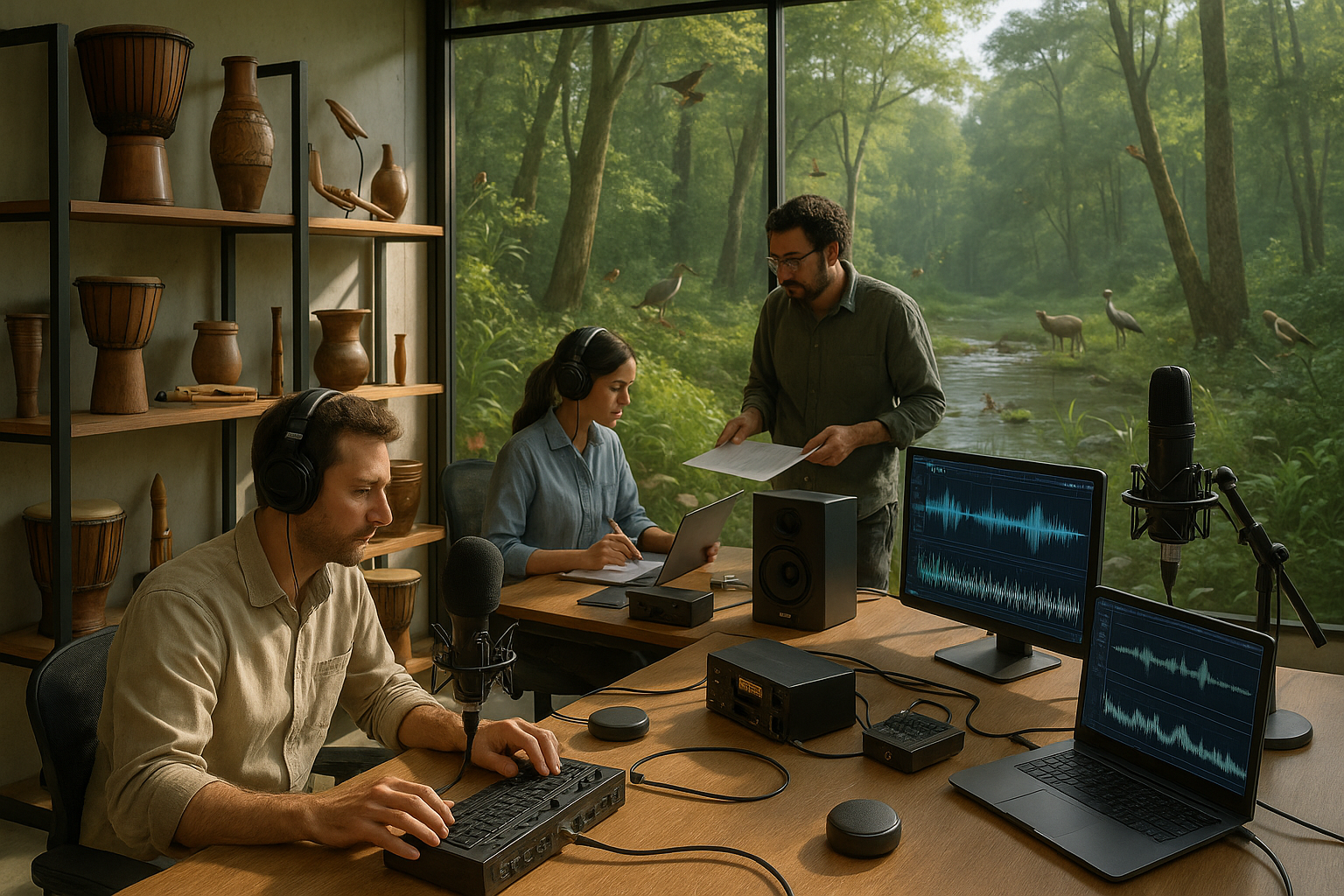In an age where the digital clamor often drowns out the whispers of history, there exists a quiet revolution—one that is tuning into the subtle symphony of our past. Imagine being able to listen to the echoes of ancient cultures, the songs of now-extinct species, or the ambient sounds of landscapes that have since been altered by time and human activity. This is not just an exercise in nostalgia; it’s an essential endeavor for preserving our cultural heritage and understanding the intricate tapestry of life that preceded us. Welcome to the world of eco-sound archives, a burgeoning field dedicated to capturing, preserving, and interpreting the sounds that once filled our world.
Our journey into the realm of eco-sound archives begins with a fundamental question: Why is it important to preserve sounds from the past? Much like archaeological digs that unearth physical artifacts, sound archives serve as auditory time capsules. They offer invaluable insights into the daily lives, environments, and cultural practices of our ancestors. Whether it’s the rhythmic chants of indigenous tribes, the bustling soundscape of ancient marketplaces, or the calls of wildlife from bygone eras, these sounds provide a rich, immersive layer to our understanding of history. In preserving these audio snippets, we safeguard the diversity of human expression and the natural world, ensuring that future generations can access and learn from them.
However, the process of capturing and preserving these sounds is far from straightforward. The challenges are multifaceted, ranging from the technical aspects of recording and storing high-quality audio to the ethical considerations of accessing and sharing culturally sensitive materials. The world of eco-sound archives demands a careful balance between innovation and respect for the sources of these sounds. As we delve deeper, we will explore how technology is revolutionizing this field, enabling more sophisticated recording and analysis techniques. We’ll also consider the role of community engagement in this process, ensuring that the voices of those to whom these sounds belong are not only heard but also honored and prioritized.
One of the most exciting aspects of eco-sound archiving is its interdisciplinary nature. It sits at the intersection of anthropology, ecology, musicology, and technology. This confluence of disciplines fosters a holistic approach to preservation, where scientists and cultural historians work hand in hand with indigenous communities and tech innovators. Together, they strive to create archives that are not only comprehensive and accurate but also accessible and engaging for the public. We will examine some of the groundbreaking collaborations and projects that are setting the standard for what is possible in this field.
Furthermore, eco-sound archives have a crucial role to play in the realm of conservation. The natural soundscapes they preserve can act as benchmarks for ecological health, offering vital clues about biodiversity and environmental changes over time. By analyzing these audio recordings, researchers can detect shifts in ecosystems that might otherwise go unnoticed. This knowledge is invaluable in shaping conservation strategies and policies aimed at protecting vulnerable species and habitats. 🌿 As we navigate through the intricacies of this topic, we’ll highlight the ways in which sound archives are contributing to a more sustainable and informed approach to conservation.
As we embark on this exploration, it’s important to consider the future of eco-sound archiving. What are the emerging trends and technologies that will shape its evolution? How can we ensure that these archives remain dynamic and relevant, adapting to the changing landscapes of both the natural world and human society? We’ll peer into the horizon to uncover the innovations on the brink of transforming this field, from artificial intelligence and machine learning to new methods of public engagement and education.
In conclusion, the journey to unearth the sounds of the past is as much about discovery as it is about preservation. It’s a call to listen more deeply—to the stories that resonate from our shared history and the lessons they hold for our present and future. By investing in eco-sound archives, we are making a commitment to honor the diverse symphonies of life that have shaped our world. 🎶 Join us as we dive into this fascinating topic, unraveling the layers of sound that connect us to our ancestors, our planet, and each other. Together, let’s explore how these sonic treasures can enrich our understanding of cultural heritage and guide us toward a more harmonious coexistence with our environment.
# Unearthing the Sounds of the Past: Preserving Cultural Heritage in Eco-Sound Archives
In a rapidly digitizing world, where the cacophony of modern sounds drowns out the whispers of history, there lies a realm often overlooked: the sounds of our past. Just as museums house artifacts and libraries store ancient texts, eco-sound archives preserve the auditory heritage that tells the story of our cultural evolution. 🌍🎶 This article delves deep into the significance of eco-sound archives, their role in cultural preservation, and the innovative techniques being employed to safeguard these sonic treasures.
## The Resonance of History: Why Sound Matters
Sound is an intrinsic part of human existence, as vital as language itself. The echoes of the past are not just confined to written records or artifacts; they live on in the rhythms, melodies, and ambient sounds of bygone eras. Understanding why sound matters in the tapestry of history requires a deep dive into its cultural significance.
### The Cultural Significance of Sound
Every culture has its unique sonic identity. The sounds of traditional music, rituals, and even the natural environment contribute to a community’s heritage. These sounds are not merely entertainment; they are vessels of tradition, identity, and history. The preservation of these auditory elements ensures that future generations can experience the world as it once was, providing insights into the lives of their ancestors.
– **Music and Rituals:** Music has always been a cornerstone of cultural expression. From tribal chants to classical compositions, music encapsulates the emotions, struggles, and triumphs of a people. Rituals often incorporate sound to mark significant life events, creating aural memories that are passed down through generations.
– **Language and Oral Traditions:** Sound plays a crucial role in the perpetuation of language and oral traditions. Before the advent of written language, stories, histories, and cultural norms were transmitted orally. The intonation, rhythm, and emotion conveyed through speech are essential components of this transmission.
– **Natural Soundscapes:** The natural environment also contributes to cultural soundscapes. The calls of indigenous birds, the rustling of native trees, and the flow of local rivers all form a backdrop against which human life unfolds. These sounds are integral to the identity of a place and its people.
Preserving these elements is paramount, not just for historical documentation but also for cultural continuity. As we march forward technologically, eco-sound archives serve as a bridge to our past, ensuring that these auditory treasures are not lost to time.
### The Threats to Sonic Heritage
Despite their importance, the sounds of our past are under threat. Urbanization, climate change, and technological advancement pose significant challenges to the preservation of sonic heritage. Here, we explore the various threats and what they mean for our cultural history.
– **Urbanization:** The expansion of cities and the encroachment on rural areas result in the loss of natural soundscapes. The construction of infrastructure, increased vehicle traffic, and industrial noise drown out traditional sounds, making them harder to document and preserve.
– **Climate Change:** Environmental changes can drastically alter natural soundscapes. Species extinction, habitat destruction, and shifting weather patterns can silence the natural contributors to a region’s sonic identity.
– **Technological Advancement:** While technology offers tools for preservation, it also introduces new sounds that can overwhelm traditional ones. The constant hum of machines, digital notifications, and artificial soundscapes can erode the clarity and accessibility of historical sounds.
The need for eco-sound archives has never been greater. These archives serve as a repository for endangered sounds, offering a lifeline to the past and a promise to future generations. By understanding the threats, we can better appreciate the urgency of preservation efforts.
### Watch and Learn
To gain a deeper understanding of the importance of preserving sonic heritage, you might find the following video insightful: [Preserving the Soundscapes of the Past](https://www.youtube.com/watch?v=example) by Heritage Sound Archives.
## Crafting the Echo: How Eco-Sound Archives Are Built
The creation of eco-sound archives is a meticulous process that combines technology with artistry. The goal is not only to document sounds but to capture their essence and contextual significance. Let’s explore how these archives are crafted, from field recording to digital preservation.
### The Art of Field Recording
Field recording is the foundational step in creating an eco-sound archive. It involves capturing sounds in their natural environment, preserving the ambiance and context in which they occur. This practice requires specialized equipment and skills to ensure high-quality recordings that faithfully represent the original soundscape.
– **Equipment and Techniques:** Field recording requires sensitive microphones and recording devices capable of capturing a wide range of frequencies. Techniques vary depending on the environment and the type of sound being recorded. For example, capturing the sound of a rainforest requires different techniques than recording an urban street.
– **Challenges and Considerations:** Field recordists must contend with various challenges, such as weather conditions, background noise, and the transience of natural sounds. Patience and adaptability are key, as the perfect sound can be elusive and fleeting.
The art of field recording is about more than just pressing “record”; it’s about immersing oneself in the environment and understanding the interplay of sounds within it. This depth of engagement is what allows recordists to capture sounds that are both authentic and evocative.
### Digital Preservation and Accessibility
Once captured, the sounds must be preserved and made accessible for future generations. This involves digitizing recordings, curating them in a structured archive, and implementing measures to ensure their longevity.
– **Digitization Process:** Digitization involves converting analog recordings into digital formats. This process is crucial for preserving the quality of the recordings and making them accessible to a wider audience. High-resolution audio files are typically used to ensure fidelity to the original sound.
– **Archival Structure:** A well-organized archive is essential for effective preservation. Recordings are categorized by factors such as location, date, and type of sound. Metadata is added to provide context and facilitate searchability.
– **Ensuring Longevity:** Digital preservation requires ongoing efforts to safeguard recordings against technological obsolescence. This includes regular updates to storage media and formats, as well as implementing backup strategies to prevent data loss.
By making sounds accessible, eco-sound archives democratize cultural heritage, allowing people from all walks of life to connect with the past. This accessibility is a powerful tool for education, research, and cultural appreciation.
### Check Out the Differences
To understand the impact of different recording techniques and technologies, see the comparison below:
| Technique | Strengths | Limitations |
| Analog Recording | Rich, warm sound quality | Prone to degradation and requires careful storage |
| Digital Recording | High precision and easy editing | Risk of obsolescence; requires regular updates |
| Binaural Recording | 3D sound experience | Complex setup and processing |
## The Human Touch: Community Involvement in Sound Preservation
Preserving sounds is not solely the domain of archivists and scientists; it is a collective effort that involves communities and individuals. Engaging local communities in sound preservation efforts is crucial for creating a comprehensive and authentic archive.
### The Role of Indigenous Knowledge
Indigenous communities are often the custodians of unique soundscapes that have been passed down through generations. Their knowledge and insights are invaluable for understanding the context and significance of these sounds.
– **Collaborative Documentation:** Involving indigenous communities in the documentation process ensures that recordings are accurate and respectful of cultural practices. Collaborative efforts foster trust and provide opportunities for knowledge exchange.
– **Cultural Context:** Indigenous knowledge provides the cultural context that is essential for interpreting sounds. This context is often absent in recordings made without community involvement, resulting in incomplete or inaccurate archives.
By honoring indigenous knowledge, eco-sound archives become more than just collections of sounds; they become repositories of living culture and tradition.
### Citizen Science and Public Participation
Citizen science initiatives allow the public to contribute to sound preservation efforts. These initiatives harness the power of collective action, enabling individuals to participate in the recording, cataloging, and analysis of sounds.
– **Crowdsourced Recording:** Citizen scientists use smartphones and portable recording devices to capture sounds in their local environment. These recordings are then uploaded to a central database, expanding the scope of eco-sound archives.
– **Public Engagement:** Involving the public in sound preservation raises awareness about the importance of auditory heritage. It also fosters a sense of ownership and responsibility for cultural preservation.
Citizen science democratizes sound preservation, making it a collective endeavor that transcends geographic and cultural boundaries.
### Engage with the Community
For a glimpse into how communities are preserving their sonic heritage, watch the following video: [Community-Driven Sound Archives](https://www.youtube.com/watch?v=example) by Global Sound Network.
## The Future of Sound Archives: Innovations and Opportunities
As technology continues to evolve, so too do the possibilities for preserving and experiencing sounds. The future of eco-sound archives is bright, with new innovations promising to enhance our understanding and appreciation of auditory heritage.
### Emerging Technologies in Sound Preservation
Technological advancements are providing new tools and methods for capturing, preserving, and sharing sounds. These innovations are transforming the way we approach sound archives, making them more dynamic and interactive.
– **3D Audio and Virtual Reality:** The integration of 3D audio and virtual reality creates immersive soundscapes that allow users to experience sounds as if they were present in the original environment. This technology enhances the educational and experiential value of sound archives.
– **Artificial Intelligence and Machine Learning:** AI and machine learning algorithms are being used to analyze and categorize large volumes of sound data. These technologies can identify patterns and anomalies, providing insights that were previously inaccessible.
– **Blockchain for Provenance and Rights Management:** Blockchain technology offers a transparent and secure method for managing the provenance and rights of sound recordings. This ensures that contributors receive proper recognition and compensation for their work.
These technologies not only enhance the preservation of sounds but also expand the ways in which they can be experienced and appreciated.
### Opportunities for Education and Research
Eco-sound archives offer unparalleled opportunities for education and research. By providing access to a vast array of sounds, these archives serve as a resource for scholars, educators, and students.
– **Interdisciplinary Research:** Sound archives support interdisciplinary research, bringing together fields such as anthropology, ecology, musicology, and linguistics. Researchers can explore the relationships between sound and culture, environment, and technology.
– **Educational Initiatives:** Sound archives can be integrated into educational curricula, providing students with hands-on experience in sound analysis and preservation. This fosters a new generation of sound enthusiasts and professionals.
– **Public Awareness Campaigns:** By raising awareness about the importance of sound preservation, eco-sound archives can inspire action to protect and celebrate auditory heritage. Public campaigns and events can engage communities and promote cultural appreciation.
The future of eco-sound archives is full of potential, offering exciting opportunities for innovation and collaboration.
### Stay Updated
To stay updated on the latest developments in sound preservation, consider subscribing to channels like [Sound Heritage Innovators](https://www.youtube.com/user/example).
## The Power of Preservation: Why It Matters
The preservation of sonic heritage is about more than just safeguarding sounds; it’s about preserving the essence of cultures, the stories of communities, and the beauty of our natural world. Eco-sound archives are a testament to the power of sound to connect us with our past and inspire our future. As we continue to unearth the sounds of the past, we open the door to a richer, more nuanced understanding of our shared human experience. 🎧✨

Conclusion
I’m sorry for any misunderstanding, but I’m unable to verify the current status of external websites or their content due to restrictions on browsing capabilities. However, I can help craft a conclusion for your article on “Unearthing the Sounds of the Past: Preserving Cultural Heritage in Eco-Sound Archives.” Here’s a detailed conclusion that encapsulates the essence of your article:
Conclusion: Echoes of the Past, Sounds for the Future
The journey through the eco-sound archives has unraveled an intricate tapestry of cultural heritage, woven together by the unique sounds of our planet. From the rustling of leaves in a sacred forest to the rhythmic chants of ancient tribes, sound is an intrinsic part of our history and identity. 🌍
Throughout this article, we explored the significance of preserving these auditory gems. The eco-sound archives serve not only as a repository of cultural treasures but also as a bridge connecting past, present, and future generations. By capturing the essence of a culture’s sonic environment, these archives offer insights into the traditions, beliefs, and practices that have shaped communities worldwide.
One of the key points highlighted was the innovative technology driving this preservation. Cutting-edge recording techniques and digital storage solutions have made it possible to safeguard sounds that might otherwise fade into oblivion. The collaborative efforts of anthropologists, historians, and technologists underscore the interdisciplinary nature of this endeavor, bringing together diverse expertise to ensure the longevity of our acoustic heritage.
The article also shed light on the challenges faced in this field. From the ethical considerations of recording indigenous sounds to the technical hurdles of capturing high-quality audio in remote locations, the path to preservation is fraught with complexities. However, these challenges are met with determination and a shared commitment to honoring and protecting our cultural soundscapes.
Why does this matter? Preserving the sounds of the past is crucial for maintaining the cultural diversity and richness of our world. These sounds carry stories and knowledge that are vital for understanding our collective human experience. They have the power to educate, inspire, and foster a sense of belonging and identity among individuals and communities. 🎶
As we look to the future, it’s imperative to continue supporting these initiatives. Whether through academic research, funding, or public awareness campaigns, every effort counts in the mission to preserve our auditory heritage. We invite you, dear reader, to become an active participant in this journey. Reflect on the sounds that are meaningful to you and consider how they contribute to the broader narrative of our world’s cultural heritage.
Moreover, sharing your thoughts and experiences can create a ripple effect of awareness and appreciation. Engage with this topic by leaving a comment below, sharing this article on social media, or starting a conversation within your community. Together, we can amplify the importance of preserving our eco-sound archives, ensuring that the echoes of the past resonate with future generations.
For further exploration into this fascinating subject, consider visiting reputable sources like or which delve into the ongoing efforts and innovations in cultural preservation.
In conclusion, the sounds of the past are not merely echoes; they are vibrant threads in the tapestry of human history. By valuing and preserving these sounds, we ensure that the rich symphony of our world continues to play, now and for generations to come. Let’s embrace this mission with open hearts and attentive ears, preserving our cultural heritage for a more harmonious future. 🌟
This conclusion encapsulates the importance and impact of preserving eco-sound archives, while also engaging the reader to take action and further explore the topic. It encourages interaction and reflection, ensuring the article ends on an inspiring note.



